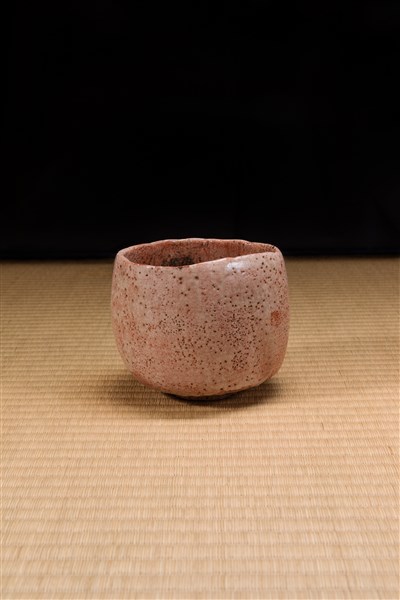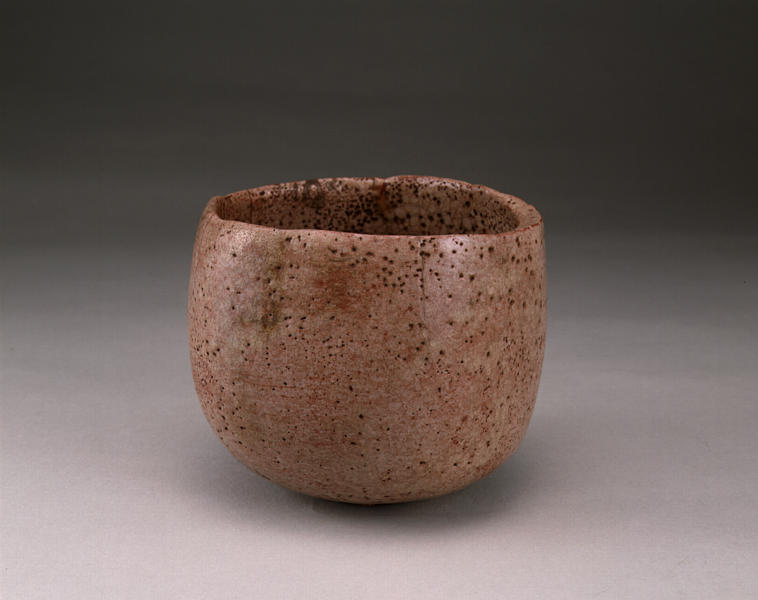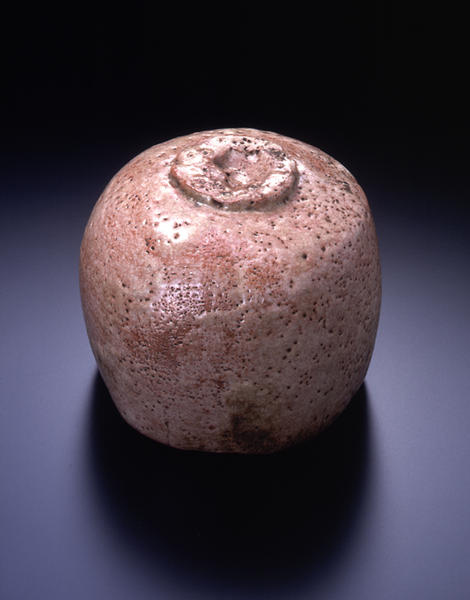赤楽茶碗 本阿弥光悦作
- 京都
- 江戸時代
- 17世紀
- 赤樂陶製
- H-10.3 D-12
解説(春の玉手箱)
刀剣の摩礪、浄拭が本来家業であった本阿弥光悦(一五五八~一六三七)は、当時京都第一流の上層町衆であり、寛永の三筆のひとりに数えられる能書家であったことはよく知られている。また、当時を代表する茶人であり、作陶に長じていたことは残されたその作品からも窺い知ることができる。光悦の作陶は、徳川家康から鷹ケ峯の地を拝領した元和元年(一六一五)以後の、すでに六〇歳を過ぎたころからであったといわれている。昵懇であった樂家二代の吉左衛門常慶とその子吉兵衛(樂家三代道入、ノンコウ)を師として、彼らの協力を得ながら光悦が作陶していたことは、光悦自筆の多くの書状に記されている。個性を発揮できる手捻りで、時折々に興の趣くままに作られた光悦の茶碗は、家業体とするのものでなくとも、自らの美意識が十二分に表されたものとなっている。
光悦の茶碗は作行きによって大きく二分される。一は白釉茶碗「不二山」に代表される半筒形のもの、一は赤釉茶碗「乙御前」や「雪峯」に代表される腰の丸い形のものである。近年、光悦茶碗として認められるものは三〇碗ほどあるとされているが、その他にも検討中のものが数碗あり、本碗もこれまで世に知られていなかった一碗である。五角形様に成形された口縁を内に抱え込ませ、胴部から腰にかけて丸みを持たせている。口縁の一部は鋭く切り回され、腰の一方もしっかりと箆で削って面取りされている。見込は広く、茶溜りはつけられていない。高台の形は不正円で、高台内をえぐるように削り、高台畳付には目跡が数箇所残っている。胎土には赤土が用いられ、全体にかけられた釉は白く、大小無数の気泡孔が生じている。全体の発色の違いを除けば「毘沙門堂」とほぼ同様の作振りといえよう。箱書の「光悦」は本阿弥光甫。
Catalogue Entry
Hon'nami Koetsu (1558‐1637) was born into a family of sword sharpeners, and thus was raised as a member of the highest ranking commoners in Kyoto. He was also an accomplished calligrapher, known as one of the Three Brushes of the Kan'ei era. He was an accomplished master of the tea ceremony and his skill at pottery is attested by the many superb works remaining by his hand. Koetsu did not start making ceramics until he was over 60 years in age, and his 1615 receipt of lands in Takagamine granted to him by the shogun Tokugawa Ieyasu. He was trained in ceramics by his close friend Kichizaemon Jokei, the second generation head of the Raku pottery family, and Kichizaemon's son, Kichibei (the 3rd generation head also known by his art names of Donyu and Nonko). They assisted Koetsu with his pottery making as documented in many letters written by Koetsu on this matter. Koetsu's tea‐bowls reveal his immediate desires for each bowl, with his handbuilding tweaking them into distinctive forms. Each fully expresses Koetsu's own personal sense of aesthetics.
Koetsu's tea bowls can be largely divided into two types. The first is a white glazed, cut cylinder form, as exemplified by Fujisan. The other is a red glazed bowl type with a rounded torso, as seen in Otogoze and Seppo. In recent years, approximately 30 bowls have been confirmed as by Koetsu, and there are also a number of bowls being considered in this regard. This bowl has previously not been known to the general public.
The mouth of this bowl has the standard five raised areas common to many tea bowls and is slightly turned in, while the torso swells to the base. Part of the mouth has been sharply trimmed, while a facet was added to the body by a sharp spatula scraping on one side of the lower torso. The interior of the bowl is broad, without a depression for tea‐pooling. The foot is an irregular circle in shape and the interior of the foot has been scraped out. There are several adhesions on the base of the foot. Red clay was used in the body of the bowl and the entire form was coated in white glaze, which then developed countless large and small bubbles in the firing. With the exception of the overall color developed here, this bowl is very close to Bishamon‐do in construction and style. The box inscription “Koetsu" was written by Hon'nami Koho.


